![]() May-June 1999
May-June 1999
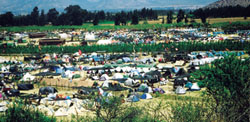 The site of the 19th World Jamboree - a large, arid hacienda called Picarquin - was located in central Chile, a predominantly farming and mining region. (Photograph courtesy of George F. Francis III) |
About 30,000 Scouts and leaders spend New Year's together in Chile during 11 days that build new friendships and strengthen the global bonds of Scouting.
The 19th World Jamboree in Chile - the first ever in South America - took place at a 7,400-acre site in the foothills of the Andes, some 38 miles south of the capital city of Santiago. For 11 days - from Dec. 27, 1998, to Jan. 6, 1999 - approximately 30,000 Scouts and leaders from nearly every Scouting association in the world assembled for a festival of friendship and Scouting spirit.
The jamboree theme of "Building Peace Together" was evident everywhere. And when jamboree Scouts weren't busy making new friends and exchanging mementos, they participated enthusiastically in a program that included full days of patrol activities. These included:
And following the jamboree, many members of the BSA contingent of 29 troops and Venturing crews - representing 996 youth and 145 adult leaders - participated in one of several specially arranged tours to different parts of Chile.
Areas visited ranged from mountains, volcanoes, and quaint towns to tropical rain forests, fishing coves, and scenic beaches.
Below is a brief sampling of how four BSA participants remember their jamboree adventure - which, all agree, was truly "an experience of a lifetime."
By Brent D. Jackson
Dec. 30 ... Our highlight was an exchange with a troop from Essex, England. We gave a demonstration of Native American dancing, followed by a few songs and then a rugged game of British Bulldog. We had watermelon and popcorn and exchanged a bolo tie that the British kids really loved. ...
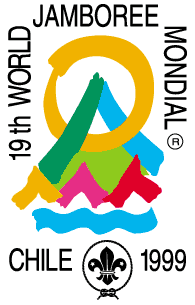
Dec. 31 ... New Year's Eve. Each country made some typical food, and people, many in native dress, went around sampling. We served buttered and salted popcorn. (Other countries have popcorn, but they eat it with sugar.) ... I really liked a dish with Chilean bread and hot pepper sauce. A Scout was ready with a "fire extinguisher" of water, but it was not that hot. He couldn't believe it when I dipped in for more. ...
Later in the evening, we had a cultural arts show ... The Samoans did a war dance that looked like slapping mosquitoes. Scouts from the Faeroe Islands did a dance in wool sweaters (they must have almost melted in the heat). The Japanese did a samurai dance with a rubber sword.
The New Year's Eve party in the Central Plaza was a blast. People were jumping, singingI came back to camp so the other Scout leaders could stay. The noise, dance, and camp-wide party went on until 2 or 3 a.m., but I was asleep before then. Earplugs were a wise investment.
Jan. 2 ... For our community service, we went to the town of Popeta, about 45 minutes away. One patrol dug a small trench to line rocks for a walkway, while others planted trees in the town plaza.
My patrol made concrete to install playground equipment on a cement slab. An older fellow named Amarillo showed us how to mix the rocks, sand, cement, and water just so, put it in a wheelbarrow, and pour it in postholes. Amarillo spoke no English and I couldn't speak Spanish, but we communicated well in gestures. I gave him a bolo tie, and he seemed very pleased.
Afterward, we went down to the river, where what seemed like the whole village was playing in the water. (It seems to be the Saturday thing to do in Popeta.) When asked why we worked so hard, [Jamboree Troop 901 assistant Scoutmaster] Ed Arnold told one man that this service was one of the main reasons we came to the jamboree, and the man started crying.
We returned to camp hot, dirty, and wholly satisfied.
Jan. 3 ... The Global Development Village featured hundreds of workshops: culture and art - straw hats, rain sticks, leatherwork, native musical instruments, ethnic foods, native dances, etc. - and science and technology - electromagnetism, water-powered vehicles, gyroscopes, fun with physics, prisms, magnets, puzzles, math, etc.
Jan. 4 ... We had the Brazilians over for an exchange. What a fun group. We took turns doing songs and dances, including the samba (that can make you tired!).
About 10 p.m. we had the evening program at the subcamp stage. For our presentation, I performed a Native American dance in regalia, and afterward several persons asked to have pictures taken with me in my feathers.
Other folk dancers and songs finished out the presentations, and the kids talked on with their new friends awhile.
Jan. 5 ... This morning the Brazilian troop assembled in front of our gateway to give us a special round of applause, in appreciation for our hospitality the previous night.
At our campfire last night we had added ashes from previous jamborees to our fire. To continue this "perpetual ash" tradition, we distributed ashes from our campfire to every campsite in the subcamp, to be saved for use at the next world jamboree.
Brent D. Jackson is assistant Scoutmaster of Troop 201, Fillmore, Utah. The above is excerpted from his account of the experiences of Jamboree Troop 901, for which he served as Scoutmaster.
By Emily Manes
Not to overuse a cliché, but [attending the world jamboree in Chile] was certainly an experience of a lifetime! Every time I saw, spoke with, or listened to someone from another country, I felt as if they were inviting me into their
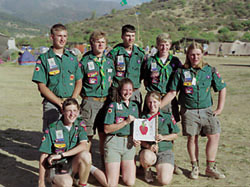 Jamboree Venturing Crew 2216 proudly displays its "American As Apple Pi" patrol flag. (Photograph courtesy of Buddy Givens) |
I spent my eating, sleeping, and waking hours with people from all over the world - a constant trip around the globe for two wonderful weeks!
Being a member of a Venturing crew has taught me more than any schoolbook could. It has shown me the world and given me a new outlook on life. Following is a quote from my college admissions essay which expresses not only what we do as a crew, but what these past four years, and especially those two weeks in Chile, have meant to me.
"I have traveled in and out of the United States with the many members of my Venturing crew. We have journeyed to a nearby CiCi's Pizza to as far away as the world Scout jamboree in Santiago, Chile. We go camping once a month with an activity in mind: rock-climbing, rappelling, spelunking, water and snow skiing, sailing, windsurfing, whitewater rafting, and much more. It is a high adventure crew in which every camp-out presents a new experience for us to work together and try to solve a problem or to succeed at a task."
Emily Manes is a member of Venturing Crew 425 in Irving, Tex.
By Leo Peters
Imagine traveling 4,000 miles from home and knowing no one upon arrival.
Imagine being among approximately 30,000 Scouts from 187 countries for two weeks.
Imagine making tons of friends from around the world during this short time - and having the time of your life!
That was part of what I experienced at the 19th World Jamboree in Chile, where I served as one of approximately 200 hike guides, or "route monitors."
I left home the day after Christmas and had a long, long flight to Santiago, Chile. From there I
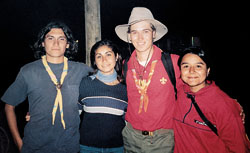 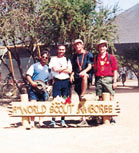 Hike
leader Leo Peters (above, in hat) was able to form friendships with Scouts and leaders from
many countries. (Photographs courtesy of Leo Peters) Hike
leader Leo Peters (above, in hat) was able to form friendships with Scouts and leaders from
many countries. (Photographs courtesy of Leo Peters) |
For the first two days, each hiking group held training sessions. We reviewed hiking safety and procedures and got to know the other members in the group.
The weather was hot (there wasn't a day when it didn't reach 100 degrees), and there never seemed to be a cloud in the sky. But I love to hike, and this was the perfect opportunity for me.
During the jamboree, I led six groups of 40 persons each on hikes of about 16 miles. The trails were in the foothills of the Andes mountains, several miles from the jamboree site. Although rugged and desert-like, the surrounding landscape had its own special beauty, with snowcapped mountains visible in the distance.
Along the way, we had simple trail meals for supper and breakfast. We slept out under the stars in a little clearing and then hiked back in the morning.
Each of my hiking groups was from a different place: Chile, Belgium, France, Honduras, Canada, and Argentina. I spent nearly a day with each group, and I was able to get to know quite a few people from around the world.
The evening campfire, attended by five hiking groups, was the highlight of each trek. Some 200 Scouts from different parts of the world joined together for a festive session. There was singing, dancing, and skits, lasting well into the night.
It was amazing to see how everyone was very different yet also very much alike. For example, all the hikers were friendly and had a great time, no matter where they came from. Of course, everyone complained about the hot, dry weather, but they all toughed it out and enjoyed the hike.
For each group, I had special memories: The Chilean Scouts (our hosts) were the friendliest and most talkative, while the Belgians asked me many questions about my home state, Texas. The French Scouts tried their best to teach me le français, the Hondurans were great hikers, and the Argentineans seemed shy at first, but became talkative once we were on the trail.
I made several good friends with whom I hope to stay in contact. There's Martin, a college student from Chile, who practiced his English while I practiced my Spanish. Robert, a young Belgian Scout, loved to quiz me about Texas, along with his friends. Juan Carlos, one of the Honduran leaders, loved hiking and the outdoors, just as I do.
I'm glad I took the opportunity to apply for a staff position. Of all the ways to participate in the world jamboree, it provided the best chance for me to get to know Scouts from around the world. And, in the process, it produced memories that will last a lifetime.
Eagle Scout Leo Peters, from Weimar, Tex., is in his second year at Rice University in Houston, majoring in chemical engineering. He serves as an assistant Scoutmaster for Troop 228, Weimar.
By Edward Roos
Troop 101 from the Northeast Region took a 12-hour flight from New York's JFK airport to Santiago, Chile, with a one-hour stop in Lima, Peru. From Santiago we were bused to our campsite at Picarquin, the jamboree site 38 miles south of the capital.
We set up the Troop 101 campsite. (Our campsite gateway featured the flags of the United States, Chile, the Transatlantic Council, and the seven states represented in our troop. I was honored to be the one
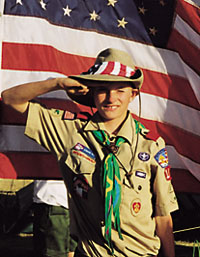 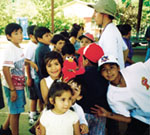 Edward Roos (left) wrote about the village service project (above) and other activities for his hometown newspaper. (Photographs courtesy of Edward Roos) |
Scouts from 187 countries attended the jamboree, and many, if not most of those associations, have coed Scout membership - a new and interesting experience for many BSA Scouts.
The jamboree theme was "Building Peace Together," and a popular activity was earning the World Peace Badge. We qualified for this by participating in activity areas such as environment, culture, science and technology, folklore and handicrafts, the Earth Which Provides for Us exhibit, and a day of service in the community.
At a ceremony on Dec. 28, Chile's President Eduardo Frei officially opened the jamboree. (I actually got to shake his hand, which was one of my lasting memories!) The next day, we went on an overnight hike, sleeping under the stars with the majestic Andean mountains in view.
The New Year's Eve celebration was something to remember, with approximately 30,000 Scouts singing and dancing away. And on Jan. 2, we competed on an obstacle course.
The jamboree officially ended with the spectacular closing ceremony on Jan. 5. We made our farewells and then set out on a three-day tour of Villarrica outside Santiago.
Highlights of the tour included hiking up a volcano and experiencing whitewater rafting. (High adventure at its best!) The volcano was dormant, and we all brought back samples of molten rock; in the rafts, we held our breath as we sped down the rapids - and got soaked! We took cable cars to the top of San Cristobal, which overlooks Santiago. We were entertained by Mapuche Indians with traditional games and dances.
The trip left me with many lasting impressions. I was able to explore the history and culture of a country; I appreciated how friendly and gracious the Chilean people were; and I understood more than ever that learning another language is very important. (The three offfcial jamboree languages were Spanish, English, and French.)
But best of all were many friendships that I made, an experience which definitely was "Building Peace Together."
Edward Roos, 13, is a member of Troop 1 in Framingham, Mass. The above was adapted from the article he wrote as a jamboree correspondent for his hometown newspaper, the Metrowest Daily News.
| The Boy Scouts of America | http://www.scouting.org |